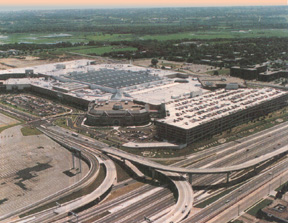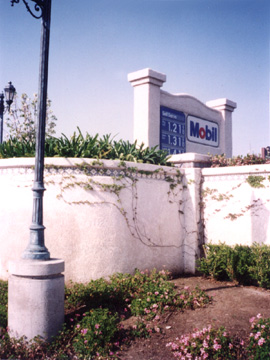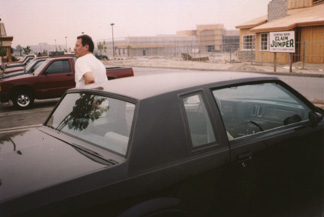|
Avoiding Sprawl

The Mall of America in Bloomington MN:
The Future?
Dream of the future, or nightmare of the Midwest?
This development is the largest mall in the world, over 10 million
retail square feet. It is about 10 times the size of most large
malls like the Galleria Mall in Cheektowaga. Although it has
a population larger than the 30,000 in Jamestown, NY, no one
lives in this "edge city". To survive, this mall needs several
tens of thousands of visitors a day all carrying credit cards.
The mall's drawing radius must therefore be several hundred
miles. Daily charter bus reservations can be made in Detroit
and Canada.
by Juan Wilson
(C) 1998 The Gobbler
Suburban sprawl has recently become a hot social,
environmental, economic and political issue. Several communities,
including New York State (Assembly 10038, Senate 7256), have
"smart growth" legislation in process. Many counties and incorporated
towns have adopted new laws aimed at curbing problems associated
with sprawl. Most of that legislation has utilized a handful
of techniques to more efficiently use land and conserve special
local features. These techniques have included:
- Master planning, zoning & land use restrictions
- Economic incentives for growth in established
population centers
- Identifying historical or environmental
conservation districts
- Encouraging mass transit and alternatives
to automobile use
These traditional methods have had moderate
success in some places like Portland, Oregon where a large population
growth in recent years (50% in the 1990's) has been absorbed
in a metropolitan area growth of only 5%. However, many environmentalists
and anti-sprawl advocates argue that the new laws often simply
enforce the status quo and become merely a new set of rules
to deal with. For example, in some Colorado communities new
land use restrictions have merely replaced the requirement for
an environmental impact statement and have actually accelerated
speculative building.
Obviously laws don't always accomplish their
goals. Two obvious examples of federal legislation underscore
this point. Federal deregulation of airlines two decades ago
and the Telecommunication Act 1994. These laws were intended
to boost competition, and, in the long run, improve service
to the consumer. To a degree, both sets of laws backfired and
have resulted in poorer local service and/or higher prices.
A similar fate may confront our county if we
are not in agreement on our real goals when we start moving
towards dealing with sprawl.
I recently attended a forum in Buffalo, NY,
on October 7, titled "Regionalism: From Agenda to Action". The
forum was sponsored by the Institute
for Local Governance and Regional Growth
(part of the University of Buffalo). This meeting was attended
by about 300 people from around the Buffalo metropolitan area.
It should be noted that this gathering was not held in a hotel
in downtown Buffalo but at the Galleria, the largest regional
shopping mall in western New York, in the heart of the beast,
so to speak.
One thing was clear at this meeting. Although
many agreed on the unfortunate downturn in the health of the
region's economy and quality of life, there was no consensus
on problem's causes or solutions. In fact there were many opposing
and contradictory agendas being addressed.
Similarly, I'm sure that here in Jamestown,
NY, many people with diametrically opposed political and economic
agendas would agree that our city is imperiled. Unfortunately,
they may be reaching for widely disparate solutions because
they perceive different sources of the symptoms they suffer
from.
Before deciding how to deal with sprawl, I
think that the first order of business is to discuss and identify
the problems associated with sprawl, and their sources. If those
items can be agreed on there may be hope to do something effective.
Sprawl has been defined as low density disperse
development extending away from existing population centers.
This kind of development has contributed to the economic failure
of our urban centers, and a suburban quality of life that has
been described as "There's no there there"and "Everywhere is
nowhere".
Although there are many aspects of American
culture that contribute to the problem of sprawl, the source
of the problem and the problem itself can be easily identified.
There are two primary components:
- The widespread use of the automobile as
a means of travel.
- The widespread use of television as a substitute
for culture.
The automobile business, through most
of this century, has been the biggest industry in the developed
world. General Motors and Standard Oil were the biggest corporations
in America for decades.

Comfy? Heavily landscaped Mobil station in Alto Loma, CA in
1994:
It's beautiful and concealed, but it's still a gas station
in a plaza on a faceless strip.
The use of the private car exploded at the
end of World War II in 1945. It has been the means of relocating
of our population from the city to outlying suburban (and now
exurban) areas where there was previously no transportation.
Of course the car itself could not do it alone.
The car needed a road to drive on. After the war, during Eisenhower's
first term, a proposal was made to build The National Defense
Highway System. It was to help us fight Communism. It quickly
evolved into the biggest public works project ever proposed.
It was renamed the US Interstate System, and has been under
construction ever since.
Since World War II television has grown as
a contributing factor to the increasing irrelevance of the city
and its culture. Why does anyone need to experience the city
center and its cultural variety? It is possible to experience
life as a voyeur watching TV in your living room, with occasional
trips to a convenience store for beer, pizza seen in advertisements.
The synergy of the car, the road and television
have created a new kind of business. The national franchise
outlet on the suburban strip. Advertised on television, supplied
by interstate tractor trailers and located within a few minutes
of anywhere, these businesses have replaced almost every local
independent business in America.
Concurrent to the development of the national
franchise outlet on the suburban strip has been the consolidation
of franchises in regional malls and shopping centers. These
centers have replaced and displaced many urban functions that
used to be public and non profit. These urban functions have
been privatized and commercialized. Subsequently, the town square
and free speech have been replaced by the mall concourse and
approved behavior on private property.

Looking for lunch on strip in Alto Loma, CA in 1994:
The Claim Jumper restaurant and discount stores under construction.
Note smog haze.
In the particular case of Jamestown there has
been another factor at work. The economic divergence of the
rust belt and sunbelt. Much of the industrial and manufacturing
loss that Jamestown has experienced has been to the sunbelt.
Jamestown is situated amid a cluster of rust belt cities that
once were the backbone of industrial America; Pittsburgh, Detroit,
Cleveland, Erie, Buffalo, Rochester, and Binghamton. These cities
were developed with heavy industry and railroads. Their large
populations were clustered around centralized resources that
were entrenched and expensive. Elaborate social and cultural
systems were also in place, like labor unions and political
organizations that made change difficult.
The synergy of automobile and television made
an end run around the need for those resources and entrenched
social structures of the city. The car and TV made it much easier
to develop and relocate businesses and people. As long as you
gave them air conditioning and cable TV it was easy to move
people away from these rust belt cities and put them in the
middle of the bug filled scrub pines of the South or the blistering
desert of the West.
For our county, here in the middle of the rust
belt and snowbelt, there has been little in the way of economic
or population growth since the depression of the 1930's. That
will change in the next century as the pressure of population
growth and the need for undeveloped real estate increase. Unless
we are prepared, sprawl will accelerate and the quality of life
will suffer in Chautauqua County.
Now is the time for a new alliance in Chautauqua
County. One that links the fate of the city to the fate of the
country. This alliance will be most effective if it is established
before there are more people in suburbs to deal with. This alliance
would have a simple premise. What is good for suburbia is bad
for both the city and country. Restated, what is good for the
car is bad for people and bad for the environment.
Any strategy that the County successfully employs
to counter sprawl will have to deal with reducing the dependency
of residents on private automobiles. The ineffective planning
strategies that the County has used in recent decades have actually
emphasized increasing our dependency on sprawl as an economic
engine. A key example are the plans to develop Route 60 as a
commercial corridor linking north and south County.
Chautauqua County is still mostly rural in
character. For this rural lifestyle to remain intact there must
be a revitalization of its villages as well as its cities. Villages
once provided people most of their daily needs; the grocery,
post office, restaurant, doctor's office, gas station, etc.
There are about twenty villages in our county. Most people not
in a city still live within a couple of miles of a village center.
For a small city like Jamestown to be viable
it needs new and refreshed economic reasons to exist. These
new economies must swim against a tide moving from the city
and counter to the city's interests. To motivate people to join
a movement against this tide, these economic rationales must
be simple ideas expressed in themes that are easily understood
and widely shared. Obviously, historic and present social realities
must be considered in relation to these themes. As a first pass
I would propose two economic themes to counter sprawl here:
- Promote Jamestown as a resurgent center
of quality furniture manufacturing
- Promote the county as a leader in alternate
cultural and spiritual activity
The people of a community must begin with a
shared understanding of their past history and present state
of development. Then they can envision what kind of place they
want to live in the future, and finally decide what needs to
be done to make that vision a reality.
Home
|